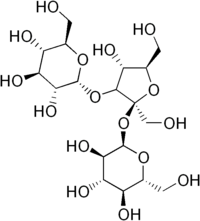Melezitose: Difference between revisions
Appearance
Content deleted Content added
Citation bot (talk | contribs) m Add: year, pages, issue, volume, journal, title, author pars. 1-2. You can use this bot yourself. Report bugs here. |
+ Image |
||
| Line 38: | Line 38: | ||
}} |
}} |
||
}} |
}} |
||
[[File:2018-07-11 - Melezitose - 3252.jpg|thumb|left|[[Honeycomb]] filled with Melezitose]] |
|||
'''Melezitose''', also spelled '''melicitose''', is a nonreducing [[trisaccharide]] [[sugar]] that is produced by many [[plant sap]] eating insects, including [[aphid]]s such as ''[[Cinara pilicornis]]'' by an enzyme reaction. This is beneficial to the [[insects]], as it reduces the stress of [[osmosis]] by reducing their own water potential. The melezitose is part of the [[Honeydew (secretion)|honeydew]] which acts as an attractant for [[ants]] and also as a food for [[bee]]s.<ref>{{cite journal | doi = 10.1046/j.0269-8463.2001.00550.x| title = Host plant and ants influence the honeydew sugar composition of aphids| journal = Functional Ecology| volume = 15| issue = 4| pages = 544| year = 2001| last1 = Fischer| first1 = M. K| last2 = Shingleton| first2 = A. W}}</ref> This is useful to the lice as they have a symbiotic relationship with ants. Melezitose can be partially [[hydrolysis|hydrolyzed]] to [[glucose]] and [[turanose]] the latter of which is an [[isomer]] of [[sucrose]]. |
'''Melezitose''', also spelled '''melicitose''', is a nonreducing [[trisaccharide]] [[sugar]] that is produced by many [[plant sap]] eating insects, including [[aphid]]s such as ''[[Cinara pilicornis]]'' by an enzyme reaction. This is beneficial to the [[insects]], as it reduces the stress of [[osmosis]] by reducing their own water potential. The melezitose is part of the [[Honeydew (secretion)|honeydew]] which acts as an attractant for [[ants]] and also as a food for [[bee]]s.<ref>{{cite journal | doi = 10.1046/j.0269-8463.2001.00550.x| title = Host plant and ants influence the honeydew sugar composition of aphids| journal = Functional Ecology| volume = 15| issue = 4| pages = 544| year = 2001| last1 = Fischer| first1 = M. K| last2 = Shingleton| first2 = A. W}}</ref> This is useful to the lice as they have a symbiotic relationship with ants. Melezitose can be partially [[hydrolysis|hydrolyzed]] to [[glucose]] and [[turanose]] the latter of which is an [[isomer]] of [[sucrose]]. |
||
<br style="clear:both" /> |
|||
==References== |
==References== |
||
{{reflist}} |
{{reflist}} |
||
Revision as of 18:35, 11 July 2018

| |
| Names | |
|---|---|
| IUPAC name
(2R,3R,4S,5S,6R)-2-[[(2S,3S,4R,5R)-4-Hydroxy-2,5-bis(hydroxymethyl)-3-[[(2R,3R,4S,5S,6R)-3,4,5-trihydroxy-6-(hydroxymethyl)-2-tetrahydropyranyl]oxy]-2-tetrahydrofuranyl]oxy]-6-(hydroxymethyl)tetrahydropyran-3,4,5-triol
| |
| Other names
Melicitose
| |
| Identifiers | |
3D model (JSmol)
|
|
| ChEBI | |
| ChEMBL | |
| ChemSpider | |
| ECHA InfoCard | 100.008.997 |
PubChem CID
|
|
CompTox Dashboard (EPA)
|
|
| |
| |
| Properties | |
| C18H32O16 | |
| Molar mass | 504.438 g·mol−1 |
Except where otherwise noted, data are given for materials in their standard state (at 25 °C [77 °F], 100 kPa).
| |

Melezitose, also spelled melicitose, is a nonreducing trisaccharide sugar that is produced by many plant sap eating insects, including aphids such as Cinara pilicornis by an enzyme reaction. This is beneficial to the insects, as it reduces the stress of osmosis by reducing their own water potential. The melezitose is part of the honeydew which acts as an attractant for ants and also as a food for bees.[1] This is useful to the lice as they have a symbiotic relationship with ants. Melezitose can be partially hydrolyzed to glucose and turanose the latter of which is an isomer of sucrose.
References
- ^ Fischer, M. K; Shingleton, A. W (2001). "Host plant and ants influence the honeydew sugar composition of aphids". Functional Ecology. 15 (4): 544. doi:10.1046/j.0269-8463.2001.00550.x.
